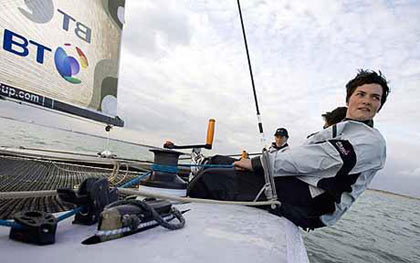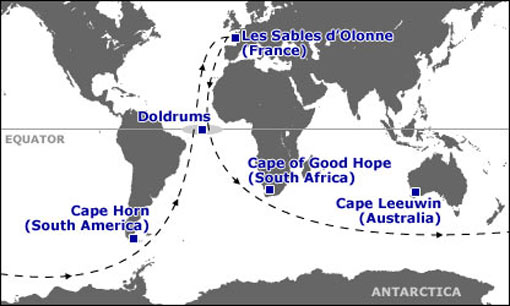You are hereBlogs / WcP.Story.Teller's blog / Vendée Globe yacht race: 23k-mile round-the-world alone, non-stop no-assist, via South Pole and back in 60ft monohulls
Vendée Globe yacht race: 23k-mile round-the-world alone, non-stop no-assist, via South Pole and back in 60ft monohulls

(quote)
The French do not lack for creativity, and some of it has been expended over the years to develop sports events. The French were the driving force behind the modern revival of the Olympics. They played a vital role in starting soccer’s World Cup and European Cup, which is now better known as the Champions League, and in Alpine skiing’s World Cup. They also dreamed up the Tour de France and the Vendée Globe yacht race.

That last event is surely the most obscure. But in France, the Vendée Globe is a major happening - a quadrennial opportunity for Gallic sea dogs and landlubbers alike to reacquaint themselves with the iceberg-infested dangers of the southern oceans and man’s (and woman’s) capacity for salt-stained, sleep-starved solitude. The concept is brutal if attractively simple: competitors race alone around the South Pole and back in 60-foot monohulls without stopping. There are strict limits on outside assistance once the sailors leave Les Sables d’Olonne on the west coast of France.

The race starts and finishes in Les Sables-d'Olonne, in the Vendée département of France; both Les Sables d’Olonne and the Vendée Conseil Général are official race sponsors. The course is essentially a circumnavigation along the clipper route: from Les Sables d’Olonne, down the Atlantic Ocean to the Cape of Good Hope; then clockwise around Antarctica, keeping Cape Leeuwin and Cape Horn to port; then back to Les Sables d’Olonne. The race generally runs from November to February; it is timed to place the competitors in the Southern Ocean during the austral summer. The race was founded in 1989 by French yachtsman Philippe Jeantot. Jeantot had competed in the BOC Challenge (now the VELUX 5 Oceans Race) in 1982-1983 and 1986-1987, winning both times; dissatisfied with the "stopping" format, he decided to set up a new non-stop race, which he felt would be the ultimate challenge for single-handed sailors.
Since the first edition in 1989, it has become common to call the Vendée Globe less of an adventure and more of a race. The number of the participants and the quality of the competitors and their yachts back that up. A record 30 competitors entered this edition, which began last Sunday with an estimated 300,000 spectators in port to bid the sailors farewell.

But it certainly felt more like an adventure than a race in the stormy first 36 hours in the Bay of Biscay, with 9 of the 30 vessels being forced to turn back toward land with problems ranging from the relatively minor (electrical issues) to the major (a crack in the hull). Among the early victims were the former winner Michel Desjoyaux of France and Bernard Stamm of Switzerland. By Tuesday night, Marc Thiercelin and Kito de Pavant had withdrawn because their yachts’ masts were damaged badly in a storm.
The race rules permit any of the unfortunates who return to Les Sables d’Olonne to start the race again before Nov. 19. But the laggards, no matter how experienced, are at a serious disadvantage considering all the sailing talent that is making headway while they make repairs. “This is a difficult race to talk about favorites,” said Loïck Peyron, a Frenchman who was leading the fleet Tuesday night. “All you’ve got to do is look at the statistics to realize that for 20 years, half the competitors don’t finish.”

The attrition rate is actually closer to 40 percent. Of the 84 sailors who have taken part in the five previous editions, 36 have not finished. Two have died, one in the opening days of the 1992 race, and one who was declared dead after disappearing in the Antarctic in January 1997. There have been several other close calls, but the last two editions have been free of death, which may be a reason for the growing number of sailors willing to take on the Everest of their sport.
The British are also becoming increasingly interested, largely because of Ellen MacArthur. She became a national icon by finishing second in the 2001 Vendée Globe. She later set a round-the-world speed record, which has since been broken, but still earned her a damehood at 28. The French continue to dominate. They have won all five editions of the race and represent the majority of the field, with 17 skippers. But the British are a strong second with seven participants, including the only two women: Dee Caffari and Samantha Davies.

MacArthur is now more interested in ecological causes and running her racing team, which is represented in this event by the young Frenchman Sébastien Josse. MacArthur’s approach has been the general rule in the Vendée Globe: make it big, then never risk it again. The race’s first three winners - Titouan Lamazou, Alain Gautier and Christophe Auguin - have sworn off the event for good, with only Gautier still involved, in an administrative role. “You don’t do this for fun,” Bruce Schwab, a solo sailor from the United States, once said. “This is the top of the heap. Once you’ve won it, there’s really no point in coming back.”
But the thinking has clearly evolved. A class of sailors now specializes in the event, despite its risks and privations. This is the fourth Vendée for Raphaël Dinelli and Thiercelin. This is the third Vendée for Dominique Wavre, Mike Golding and Roland Jourdain. Most tellingly, the last two winners - Desjoyaux and his former acolyte Vincent Riou - are back for more with new yachts. “I actually did enjoy myself in 2004,” Riou said in an interview before the start. “Human nature dictates that with time, we block out all but the good memories.”
Desjoyaux scrambled to fix his cutting-edge yacht Foncia back in Les Sables d’Olonne. By Tuesday morning, he was sailing again, but would be well advised to hurry. This looks like quite a race as well as an adventure.
(unquote)
Photos courtesy of Jacques Brinon/Associated Press, PA, Sail World, EPA, the Artemis Transat 2008, BBC News, Wayzata Community Sailing Center, UKSA, and AFP
Original Source: NY Times and Wikipedia
Related Articles: Ellen MacArthur: Vendee Globe experience changes your life forever, The Vendee Globe: Helm and high waters, and Jonny Malbon UKSA graduate enters Vendee Globe
Official Site: Vendée Globe



















If you fancy following the Vendee in a bit more detail I'm writing a blog called https://jonnymalbon.com. Jonny's the 34 year old skipper of another British boat called Artemis. I'm his brother and his friends and family are working together to cover the 26,000 mile race using only a blog and Twitter. Jonny is 'tweeting' from the boat as he goes (as far as we know this is a first) and they go directly onto the blog. Come and let us know what you think. It's all a bit of an experiment but it's fun. We're using free media to see if we can do something different and a bit more organic than the 'official' race sites.
If you fancy following the Vendee in a bit more detail I'm writing a blog called https://jonnymalbon.com. Jonny's the 34 year old skipper of another British boat called Artemis. I'm his brother and his friends and family are working together to cover the 26,000 mile race using only a blog and Twitter. Jonny is 'tweeting' from the boat as he goes (as far as we know this is a first) and they go directly onto the blog. Come and let us know what you think. It's all a bit of an experiment but it's fun. We're using free media to see if we can do something different and a bit more organic than the 'official' race sites (which all look ridiculously expensive but lack a sense of community). Tim Malbon